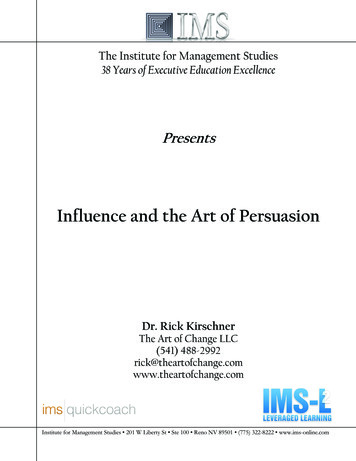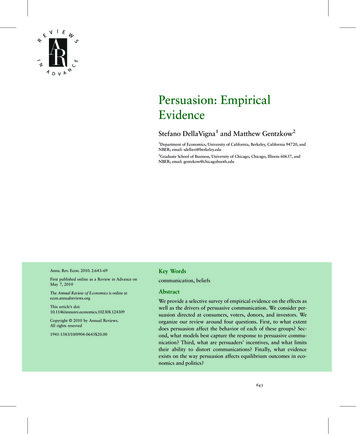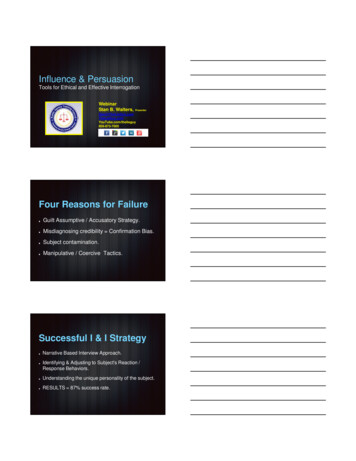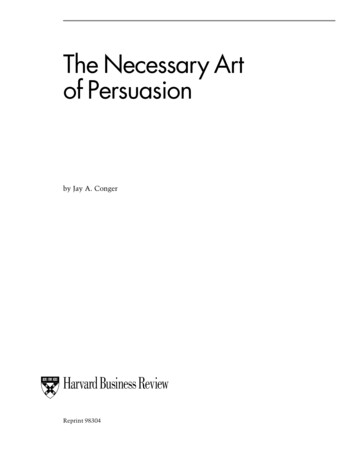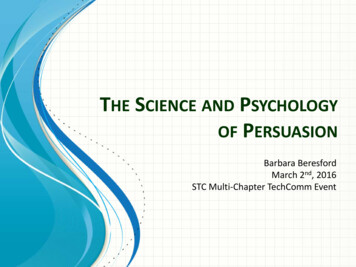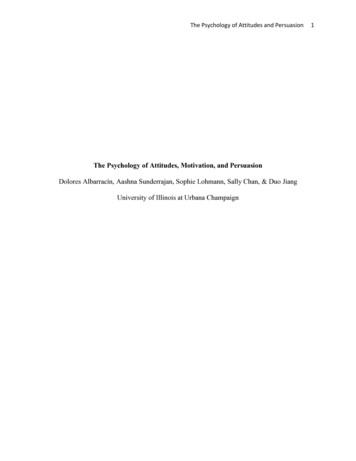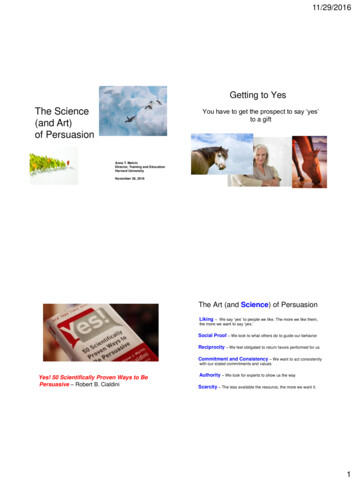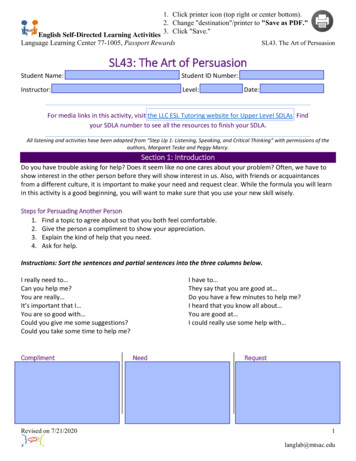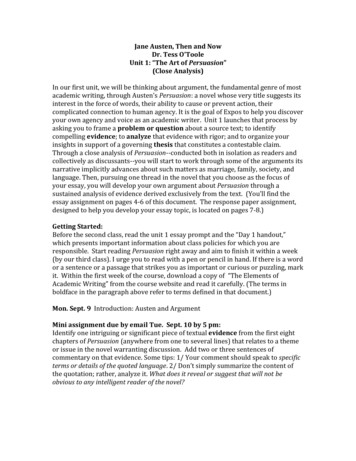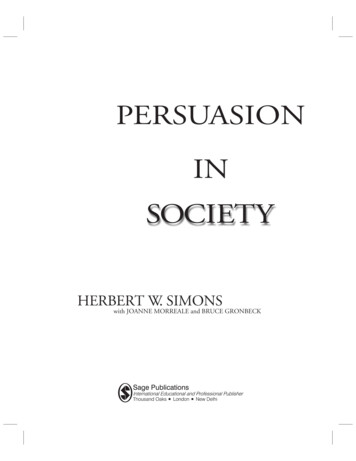
Transcription
PERSUASIONINSOCIETYHERBERT W. SIMONSwith JOANNE MORREALE and BRUCE GRONBECK
Table of ContentsList of Artwork in Persuasion in SocietyAbout the AuthorAcknowledgmentsPrefacexivxviixixxxPart 1: Understanding Persuasion1. The Study of PersuasionDefining PersuasionWhy Is Persuasion Important?Studying PersuasionThe Behavioral Approach: Social-Scientific Research onthe Communication-Persuasion MatrixThe Critical Studies Approach: Case Studies and “Genre-alizations”SummaryQuestions and Projects for Further Study351014151720212. The Psychology of Persuasion: Basic PrinciplesBeliefs and Values as Building Blocks of AttitudesPersuasion by Degrees: Adapting to Different AudiencesSchemas: Attitudes as Knowledge StructuresFrom Attitudes to Actions: The Role of Subjective NormsElaboration Likelihood Model: Two Routes to PersuasionPersuasion as a Learning ProcessPersuasion as Information ProcessingPersuasion and IncentivesPersuasion by Association25272932343436373839
Persuasion as Psychological Unbalancing and RebalancingSummaryQuestions and Projects for Further Study3. Persuasion Broadly ConsideredTwo Levels of Communication: Content and RelationalImpression ManagementDeception About Persuasive IntentDeceptive DeceptionExpression GamesPersuasion in the Guise of ObjectivityAccounting Statements and Cost-Benefit AnalysesNews ReportingScientific ReportingHistory TextbooksReported Discoveries of Social ProblemsHow Multiple Messages Shape IdeologiesThe Making of McWorldSummaryQuestions and Projects for Further Study40414247495151525455555657585959636668Part 2: The Coactive Approach4. Coactive PersuasionUsing Receiver-Oriented ApproachesBeing Situation SensitiveCombining Similarity and CredibilityBuilding on Acceptable PremisesAppearing Reasonable and Providing Psychological IncomeUsing Communication ResourcesSummaryQuestions and Projects for Further Study7374767982858688895. Resources of CommunicationResources of LanguageIntensify/Downplay939595
Hugh Rank’s Six Components of Intensify/DownplayCompliance-Gaining TacticsNonverbal ResourcesVisual and Audiovisual ResourcesResources of the New MediaSummaryQuestions and Projects for Further Study961021041081101111126. Framing and ReframingMetaphors as FramesCreative Reframing Through Generative Metaphors“Frame” as MetaphorCultural Frames and Verbal RepertoiresResearch on Frames and ReframesMetacommunicative FramesReflexive MetacommunicationsResponsive MetacommunicationsReframing in Political Confrontations: “Going Meta”Reframing in PsychotherapySummaryQuestions and Projects for Further Study1151171191201211231241241251251281301327. Cognitive ShorthandsCialdini’s Seven PrinciplesContrastReciprocityConsistencySocial ProofLikingAuthorityScarcityMother Turkeys or Faulty Automatic Pilots?The Mother Turkey HypothesisA Critique of the Mother Turkey HypothesisAn Alternative Hypothesis: The Faulty Automatic PilotThe Highly Persuasible PersuadeeGet-Rich SchemeTelephone System 50151
SummaryQuestions and Projects for Further Study8. Reasoning and EvidencePropositions of Policy, Fact, and ValueChanging, Repairing, or Retaining a Policy: The Stock Issues RevisitedTypes of Evidence as Resources of ArgumentationFallacies ReconsideredThe Case of Gulf War SyndromeSummaryQuestions and Projects for Further Study152153155158161167171174175177Part 3: Contexts for Persuasion9. Going PublicThe Genuinely Committed PersuaderStrategic Planning: A Three-Step ProcessStep 1: Goals, Audience, SituationStep 2: Initial StrategizingStep 3: Test-Marketing and RevisionOrganizing MessagesIntroductionBodyConclusionIssues in Message DesignExplicit Versus Implicit Conclusion Drawing“One-Sided” Versus “Both-Sided” PresentationsMagnitude of Discrepancy ControversyFear AppealsAdapting to Different AudiencesSummaryQuestions and Projects for Further Study10. Planning CampaignsCampaign PlanningSetting Campaign 205207208211212212
Undertaking Research and DevelopmentFormulating a Basic StrategyMobilizing for a CampaignSeeking Legitimacy for a CampaignPromoting a CauseActivating Campaign AudiencesTypes of CampaignsIndoctrination CampaignsPublic Relations CampaignsCorporate Issue AdvocacyCrisis Management CampaignsSummaryQuestions and Projects for Further Study11. Staging Political CampaignsPersuasion in the Four Stages of Presidential CampaigningPre-Primary Period (Surfacing)Primary Period (Winnowing)Convention Period (Legitimating)General Election Period (Contesting)Machiavellianism in Political Campaigns:A Guide to Getting Elected to High OfficeGeneral StrategiesFundraisingPhysical AppearanceChoosing Arguments and AppealsVideo PoliticsAdvertisingEndorsementsSpeech MakingCampaign DebatesCampaign Decisions That Matter: Five Case StudiesCase 11.1: “Furlough” AdCase 11.2: A Place Called HopeCase 11.3: Should Dole Have Attacked Clinton’s Character in 1996?Case 11.4: Clinton’s Early Issue Advocacy AdvertisingCase 11.5: George W. Bush Campaign in South CarolinaSummaryQuestions and Projects for Further 3266267269271272
12. Analyzing Product AdvertisingThe Changing Character of Advertising CampaignsIdolatry (1890-1925)Iconology (1925-1945)Narcissism (1945-1965)Totemism (1965-1985)Case Study: The Best BeerToday’s Advertising: The Pantheistic PhaseNarrowcastingBreaking With Tradition: Anti-AdsMisdirection in the Language of AdvertisingVisual Deception in Product AdvertisingSubliminal AdvertisingSummaryQuestions and Projects for Further 13. Talking Through DifferencesPersuasion in Social ConflictsCooperation and Competition in Mixed-Motive ConflictsSymmetrical Versus Asymmetrical ConflictsProductive and Destructive ConflictsDealing With Conflicts ProductivelyGetting to Yes in Business NegotiationsPublic DebatesThe Persuasion DialogueMoving to Dialogue in Interpersonal ConflictsCase 1: A Taped Conversation About a Taped ConversationCase 2: A Structured Conversation About AbortionSummaryQuestions and Projects for Further Study29930030230330530630931031431631632032332414. Leading Social MovementsWhat Are Social Movements?Types of Social MovementsTactics of Social MovementsConfrontationCultural Politics329332333334335335
Social Protests and Mass MediaLeading Social Movements:The Requirements-Problems-Strategies (RPS) ApproachRequirementsProblemsStrategiesOpen- and Closed-Minded MovementsThe Fate of Social MovementsSummaryQuestions and Projects for Further Study33633833933934134634834935115. More About EthicsPerspectives on EthicsPragmatismUtilitarianismUniversalismDialogic EthicsSituationalismThe Ethics of Faculty Advocacy in the College ClassroomThe Mindful SocietyPrime-Time Entertainment SelloutNewspaper SelloutThe Ethics of Being Ethically SensitiveSummaryQuestions and Projects for Further endix I: Resources for the PersuaderAppendix II: Different Strokes for Different FolksAppendix III: Ethical, Unethical, or Borderline? A Self-SurveyIndex381385389401
PrefacePersuasion in Society is an integrative, comprehensive guidebook to understanding, practicing, and analyzing persuasion. It brings together the academic contributions of humanists and social scientists and adds to them the insightsof professional persuaders and communication analysts. That the study of persuasion is important—indeed vital—should need little argument. Human beings areboth creators and products of their societies in a never-ending cycle. In the UnitedStates, our economic system, our republican form of government, our commitmentsto freedom of speech and religion and to equality of opportunity, our conceptions ofourselves as a sovereign people, and even our idea of nationhood can be traced to efforts at persuasion in centuries past. Indeed, there is scarcely a cultural truism thatwas not at one time or another the subject of considerable controversy. What is considered true today is certain to be questioned in the future as new efforts at persuasion take the place of the old.Understanding society, then, requires understanding persuasion. The study ofpersuasion also has direct, personal payoffs. A recent survey of 2,800 executives bythe American Management Association asked, “What is the No. 1 need for success inbusiness today?” The overwhelming response was “to persuade others of my valueand the value of my ideas” (Story, 1997, p. 3).Persuading others is one side of the persuasion equation; the other is respondingintelligently and discerningly to the armies of message makers who compete for yourattention, your agreement, your involvement, and your money. Persuasion is the engine of our market-driven global economy, say the authors of a recent article inthe American Economic Review—its title: “One Quarter of GDP Is Persuasion”(McCloskey & Klamer, 1995).In our increasingly smaller but more complicated world, being an intelligentconsumer of persuasive messages is not easy. Take the problem of message density.xx䊴
PrefaceToday, many more persuasive messages are presented to us at dizzying speeds. Tonsof information are available at the click of a mouse. Yet how should we process it all?How can we make wise judgments when there are so many to be made? One obvioussolution for persuadees is reliance on cognitive shorthands (e.g., “Doctor knowsbest,” “The majority must be right,” and “She’s too cute to turn down“). Yet whenare they reliable, and when are they not? When they’re not, can we “say no” to them?When we need more than cognitive shorthands, how can we best come to judgment?Persuasion in Society is written for the would-be persuader as well as thepersuadee. It assists persuaders in thinking through issues, then preparing to engageaudiences, whether for a one-shot persuasive speech or a long-term campaign ormovement. It likewise assists persuadees by sensitizing them to the wiles of persuaders, including the persuader’s capacity to overcome audience defenses by appearingnot to be attempting persuasion at all.This book’s dual perspective, its shifting between the roles of persuader andpersuadee, is also designed to place ethical questions in persuasion front and center.The central ethical problem was put by Aristotle in the first systematic treatise onrhetoric (i.e., persuasion), written thousands of years ago. Persuasion, he observed,gives effectiveness to truth, but it also gives effectiveness to error, bad judgment, anddeliberate falsehood.Moreover, deception comes in degrees and is not always harmful to others. Sowhose perspective should we adopt as we confront persuasion’s many ethical dilemmas: that of the persuader or the persuadee? (Audiences tend to be far less forgivingof persuaders than persuaders are of themselves.) My approach in repeatedly shiftingbetween perspectives is to cause sometimes painful, but I hope illuminating, doublevision.Persuasion in Society was written for the “beginning” student of persuasion, butthis is a term that fairly begs for clarification. Chances are that you began figuringout how to persuade before your first birthday. First, you cried because your bellyhurt. That was biology, not persuasion. But soon you learned that if you could act asif your belly hurt, whether it did or not, then you could get your mother’s attention,perhaps even her sympathy. That may well have been the beginning of your career asa student of persuasion—an ignoble beginning, built on deception, but a beginningnonetheless.Well, you’re a bit older at this point. Putting technicalities aside, let’s call you abeginning persuasion student if this is your first persuasion course and if you are oftypical college age, say 18 to 25. The persons who have studied your generation report that your attitudes toward schooling and habits of study are quite different fromthose of your baby boomer parents, and different still from those of my generation(Hamlin, 1998). Some important differences so far as this book is concerned arethese: You like your lessons tight, succinct, and arrestingly illustrated—just like ontelevision. You’re not much for newspaper reading or even for network television䊳xxi
xxii䊴PERSUASION IN SOCIETYnews, but you respond well to the conversational style of television talk shows. Aschannel surfers and Internet browsers, you look for what interests you and turn offthe rest. Some observers claim that you’re not very critical message recipients—you’re highly selective about getting entertainment but not about gathering information for a speech or term paper.Persuasion in Society will try to meet you halfway: lively, yes, but not at the priceof cutting back on a point that needs development; interesting visuals, but selectedmore to instruct than to entertain. Indeed, a good deal of the “teaching” that takesplace in this book is around visuals. As for reports that you’re not very critical message recipients, I hope that’s not true, but if it is, Persuasion in Society should help youdo better.It is not an exaggeration to say that this book was at least 40 years in the making.My earlier text on the subject, Persuasion: Understanding, Practice, and Analysis(Simons, 1976/1986), has been so thoroughly reconceptualized and updated thatmy editor and I feel justified in calling Persuasion in Society a new book, rather than arevised edition of the earlier text. Some things have not changed, including my mostbasic convictions that persuasion is about winning beliefs, not arguments; that communicators who seek to win belief need to communicate with their audiences, not atthem; and that persuasion at its best is a matter of giving and not just getting—ofmoving toward persuadees psychologically, recognizing that they are most likely togive you what you want if you can show them that what you propose also gives themwhat they want. This is the essence of my coactive approach to persuasion, which involves reasoning from the perspective of the other or, better still, building from common ground.Persuasion in Society also remains focused on clear-cut instances of attemptedpersuasion—called paradigm cases—but gives increased attention to cases in whichintent to persuade is not so obvious. I’ve become convinced, for example, that popular entertainment programming, as in television sitcoms, does more to shape American values—indeed, the media-connected world’s values—than do sermons and editorials, political oratory, and parental advice. Yet seldom do people think of sitcomsas forms of persuasion. Also occupying a place in what I call the gray areas of persuasion’s domain are newscasts, scientific reports, classroom teaching, and, yes, textbooks such as this one—all rendered especially credible by appearing in the guise ofobjectivity.The preview that follows highlights some of this book’s distinctive features. One ofthose features, amply illustrated in the first chapter of Part 1, is the book’s heavy reli-
Prefaceance on stories as a pedagogical tool. Chapter 1 uses stories to address fundamentalissues: What is persuasion? How is it different from other forms of communicationand other forms of influence? In that persuasion deals in matters of judgment ratherthan certainty, how trustworthy is it? If, on some controversial issues, well-informedexperts may reasonably disagree, does this mean that any persuasive argument is asgood as any other? The chapter also introduces the behavioral and critical studies approaches to the study of persuasion, the one social-scientific, the other derived fromthe humanities. Persuasion in Society draws on both of these approaches, attemptingto take the best from each.In introducing basic psychological principles, Chapter 2 pulls together behavioral theory and research on the psychology of persuasion but not in an exhaustiveway, as might a text devoted exclusively to the behavioral approach. Rather, the aimof the chapter is to derive principles from theory and research that have practicalpayoffs as guides to the practice and analysis of persuasion. Broached in Chapter 2for purposes of illustrating the psychology of persuasion is President Clinton’s handling of the Monica Lewinsky scandal. I return to this case study in subsequent chapters, focusing especially on President Clinton’s speech of August 17, 1998, in whichhe admitted to an affair with the White House intern.Chapter 3 moves beyond paradigm cases to begin this book’s exploration of thegray areas of persuasion. Its key principle is that the same communicated messagemay be multimotivated, be multileveled, and have multiple effects—thus perhapspersuading and serving other communicative functions at the same time. In additionto alerting readers to persuasion’s many guises and disguises, Chapter 3 raises concerns about mass persuasion’s cumulative ideological effects.Part 2 of Persuasion in Society develops principles of coactive persuasion that areintroduced in Chapter 4. Whatever your goals as a persuader, whatever your audience and situation, says the coactive approach, you should be engaged in a process ofbridging differences by moving toward the persuadee psychologically. Usually, thisinvolves building on common ground between the two of you, but sometimes it requires that you put aside your own perspective and attempt persuasion from the perspective of the persuadee. Emphasized here is the importance of situational analysisand audience adaptation as preconditions for bridging the psychological divide between persuader and persuadee. Also introduced are ways of combining credibilityand attractiveness, reason, and emotion.The remaining chapters of Part 2 elaborate on the principles of coactive persuasion introduced in Chapter 4. Focusing on paradigm cases, as opposed to those inthe gray areas of persuasion, they identify resources of communication that are available to the persuader, including those classified by Aristotle under the headings ofethos, pathos, and logos. For Aristotle, ethos referred to the person of the persuader asperceived by the audience. Pathos translates most immediately into appeals to emotion but includes incentives of every type. Indeed, there is no clear separation be-䊳xxiii
xxiv䊴PERSUASION IN SOCIETYtween pathos and logos, the apparent logic of the message, as you should see in thechapters on cognitive shorthands and on argument.Chapter 5 identifies verbal, nonverbal, and audiovisual resources of communication that are available to the persuader. What can you do to play up a piece ofnews? What can you do to play it down? How can you get a friend to comply withyour request? How can you turn down a friend’s request without endangering thefriendship? Think of these vast resources as components of a giant rhetorical toolchest, to be drawn on as the situation requires.Chapter 6, on framing and reframing, focuses on ways that persuaders may leadpersuadees to think “outside the box.” Not infrequently, the same facts can be reconfigured or recontextualized; for example, a near-certain disaster reframed as an opportunity. Brought together in this chapter are behavioral research on framing effectsand critical studies across a wide range of cases, from political confrontations topsychotherapy.Chapter 7, on cognitive shorthands, performs double duty. It first draws on apopular book on persuasion, Cialdini’s Influence: Science and Practice (1993), as asource of useful insights about how to persuade. The chapter then illustrates persuasion in the guise of objectivity by analyzing Cialdini’s book as rhetorical in its ownright, warranting critical scrutiny. Does rhetorical criticism detract from social science? Not according to social scientist Joseph Gusfield (1976). Rhetoric criticismmakes for better social science, he argued. That, in any case, is the goal of Chapter 7.It aims at deepening your understanding of cognitive shorthands, rather than undoing Cialdini’s basic contribution.Chapter 8, on reasoning and evidence, focuses on how to build a case for oragainst a policy proposal. While Chapter 7 concentrates on the sort of snap decisionmaking required of all of us in our fast-paced, message-dense society, Chapter 8 isabout how to come to judgment and then get audiences to share that judgment onissues requiring careful thought and deliberation.Part 3 of this book honors the differences in contexts for persuasion and examines some of the more significant ones with a view toward suggesting principles distinctive to each. The need for Part 3 should be apparent from the variety of paradigmcases identified in Chapter 1 and from the brief discussion of gray areas of persuasion. For example, when you stand up and deliver a classroom speech, there is littleadvanced opportunity to question those you’re trying to persuade. If you’re a political candidate or a product advertiser, you may have an audience of millions and abudget that enables you to test-market messages scientifically and then air themnumbers of times. If you’re leading a protest movement, you may not be able to paythe bus fare of the people you’re bringing to city hall for an all-day demonstration. Ifyou’re in a conflict situation, you will find that you’re at least as much a persuadee asa persuader. Moreover, you and your adversary may not restrict your modes of influence to persuasion alone.
PrefaceChapter 9, on going public, is about readying yourself for that moment whenyou present your ideas before an audience. For unprepared and overprepared speakers, it is often an unnerving experience, but this chapter provides ways to combinepassion and polish. Featured in the chapter is a three-step approach to persuasivemessage preparation that begins with goal setting and ends with test-marketing. Thechapter concludes with lessons from research on message design and on adaptationto different types of audience.Chapter 10, on campaign planning, identifies stages and components of organized, sustained efforts at persuading others, as in campaigns to discourage teenagesmoking or to encourage charitable giving. Featured in this section are guides to conducting small-scale campaigns of a sort that students can plan and execute. Chapter10 then takes up the topic of indoctrination campaigns, ranging from the benign(e.g., campaigns designed to make good citizens of us all) to the highly controversial(e.g., recruitment campaigns by religious cults). Briefly surveyed here, too, is the roleplayed by persuasion in public relations, particularly in crisis management campaigns.Chapter 11 focuses on modern political campaigns, particularly those for thepresidency, in which virtually nothing is left to chance. Here we see the best in persuasion that (a lot of ) money can buy. We also sometimes see the excesses of rhetorical combat, as in attack advertisements that prompt false inferences when they arenot fabricating outright. Chapter 11 features a tongue-in-cheek “MachiavellianGuide” to getting elected to high office, inviting readers to confront for themselvesthe ethical dilemmas that candidates face on a regular basis. A typical principle: Raiseas much money as you can as early as you can, all the while deploring America’s corrupt system of campaign financing.Chapter 12, on product advertising, looks first at its history, identifying at eachstage certain characteristic goals and strategies, then showing how they don’t somuch get dropped as added to by each new generation of advertisers. Today’s advertising—including the so-called anti-ad—gets the lion’s share of attention in the remainder of the chapter, with sections on visual persuasion in advertising and on deceptive advertising language.Chapter 13 examines situations in which interactants shift back and forth between the roles of speaker and listener, persuader and persuadee. The chapter focuseson interpersonal conflict situations, those in which people who live together, worktogether, and so forth find themselves locked in a struggle over seemingly incompatible interests. It concludes on a positive note with a vision of the ideal persuasion dialogue and with case studies of productive conversation.Chapter 14 examines another type of struggle, that waged by social movementsin behalf of causes they consider just. As with interpersonal conflicts, the study ofconflicts between movements and the institutions and countermovements they oppose requires exploring new principles of persuasion, different from those that apply䊳xxv
xxvi䊴PERSUASION IN SOCIETYto nonconflict situations, such as mere differences of opinion between friends. Theresources available to movement leaders also stand in sharp contrast, say, to those ofother campaigners.Besides offering chapters on the one-shot message, on various forms of campaigning, on advertising, on social movements, and on persuasion in interactive situations, Part 3 pulls together in a concluding chapter questions about the ethics ofpersuasion. Featured in Chapter 15 is a discussion of the ethics of faculty advocacy inthe college classroom. Do your professors attempt to persuade you, or do they maintain a stance of strict neutrality in the classroom, even in discussions of highly controversial issues? What should be their role? Is it the professor’s job to profess, as onescribe has argued? Is it to teach you how to think, not what to think? Is neutrality impossible on controversial issues, and are those professors who claim to be “tellingit like it is” really masking their own persuasive intent? Finally, you will find three appendices in this book. Appendix I pulls together theories of persuasion to provide a compendium of “how-to” principles on the science and art of persuasion. Appendix II lists tactics of persuasion appropriate to different types of audiences.Appendix III presents in one place 116 issues of ethics vs. effectiveness that wereraised in the book, and invites you to revisit them.PERSUASION IN SOCIETYCialdini, R. B. (1993). Influence: Science and practice (3rd ed.). New York: HarperCollins.Gusfield, J. (1976). The literary rhetoric of science: Comedy and pathos in drinkingdriver research. American Sociological Review, 41, 16-34.Hamlin, S. (1998). What makes juries listen today. Little Falls, NJ: Glasser LegalWorks.McCloskey, D. N., & Klamer, A. (1995). One quarter of GDP is persuasion. AmericanEconomic Review, 85, 191-195.Simons, H. W. (1986). Persuasion: Understanding, practice, and analysis. New York:McGraw-Hill. (Original work published 1976)Story, R. (1997). The art of persuasive communication. Aldershor, UK: Gower.Acknowledgments
UNDERSTANDING PERSUASION1Study of PersuasionCHAPTERThe Study of PersuasionDefining PersuasionWhy Is Persuasion Important?Studying PersuasionSummaryQuestions and Projects for Further StudyReferencesInvestigative journalist Janet Malcolm (1999) tells the story about a defenseattorney who wound up in jail for a year because she could not, or would not,tell a persuasive story in her own defense. Instead of winning an acquittal for her client, she wound up incriminating herself—or so a jury found. The prosecution convinced the jurors that the woman had crossed the line between defending a con artistand collaborating with him. Yet the woman was innocent, Malcolm insists. Indeed,she was too innocent! Had she assembled for the jurors a convincing narrative fromthe wholly accurate facts at her command, any jury would have acquitted her. Butthe woman did not believe in coherent, convincing narratives. She preferred whatshe thought of as the raw, objective truth—what really happened—however messy,incoherent, and unsatisfying. And so the woman, says Malcolm, was figurativelyguilty of another crime: She bored her jurors to death.In one of Plato’s Dialogues on persuasion, the conversation turns on the questionof whether rhetoric, the art of persuasion, is a corrupt art. As was his habit in theAUTHOR’S NOTE: As an additional convenience for readers, page numbers are provided for some cites,even when not required by usual citation standards. 3
4§UNDERSTANDING PERSUASIONDialogues, Plato (n.d./1952) has his mentor, Socrates, speak for him, while Gorgias,for whom the Dialogue is named, serves as the principal antagonist.Gorgias begins the debate by observing that the ability to impress an audience isthe surest path to power and influence. His student, Polus, adds that power is thegreatest good. Socrates will have none of it. Rhetoric, he maintains, is an art of gulling the ignorant about the justice or injustice of a matter, without imparting any realknowledge. Rhetoric does great damage to the world by making the worse appear thebetter argument and allowing the guilty to go free (Smith, 1998).Years later, Plato’s student, Aristotle, would offer a defense of rhetoric (Cooper,1932). Aristotle’s response to Plato (and to Socrates) concedes the dangers of rhetoricbut rejects their alleged inevitability. Rhetoric can be—indeed, often is—an instrument for giving effectiveness to truth. He adds that truth is not always easy to comeby. Still, those deliberating about issues of policy have a need to come to judgment,and those brought before the court of justice have the right to defend themselves.Only philosophers such as Plato and Socrates have the luxury of suspending judgment until they have arrived at universal principles. In the meantime, ordinary citizens will need help as decision makers in assessing alternative courses of action and aspersuaders in determining from among the available means of persuasion what isbest said to this audience on that occasion.Both Plato’s critique of rhetoric and Aristotle’s defense of it contain a good dealof wisdom, but as you might have anticipated, this book gives Aristotle the edge inthe debate. To be sure, rhetoric can be used to deceive, mislead, exploit, and oppress.Clever persuaders can exploit what Aristotle called the “defects of thei
2. The Psychology of Persuasion: Basic Principles 25 Beliefs and Values as Building Blocks of Attitudes 27 Persuasion by Degrees: Adapting to Different Audiences 29 Schemas: Attitudes as Knowledge Structures 32 From Attitudes to Actions: The Role of Subjective Norms 34 Elaboration Likelihood Model: Two Routes to Persuasion 34
